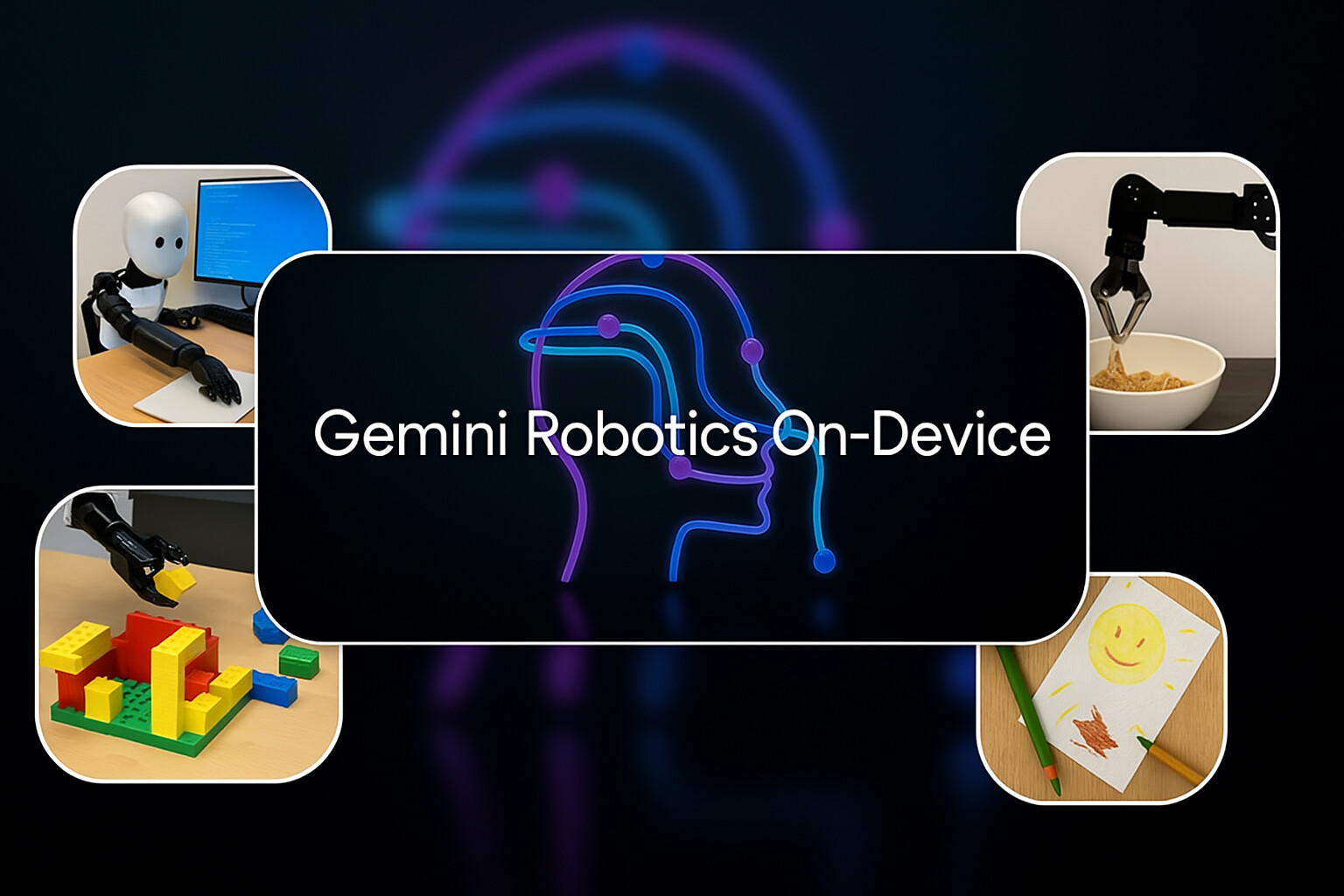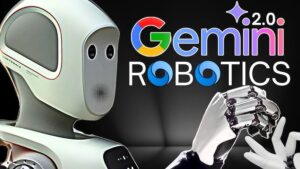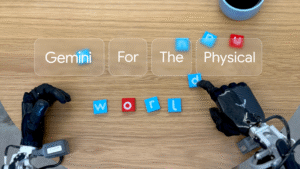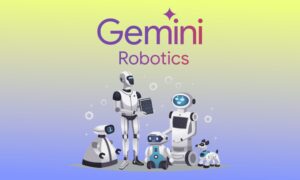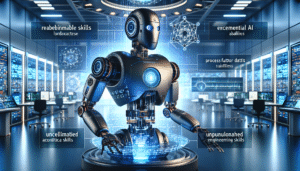Google’s Gemini Robotics for on-device AI in robots
Google DeepMind’s Gemini Robotics On-Device brings vision-language-action (VLA) models onto robot hardware — trading some cloud-scale power for low latency, privacy, and resilience. This article explains what the on-device variant is, how it differs from cloud/hybrid approaches, the technical and practical tradeoffs, real-world uses, developer tooling and safety considerations, and what this means for the future of autonomous robots. Google DeepMind+1
1. Why on-device robotics matters now
Robotics has long been split between two extremes: very smart cloud-connected systems that rely on remote compute and high bandwidth, and simple embedded systems that execute tightly constrained programs (pick-and-place loops, line following, etc.). The last few years have pushed the pendulum toward more capable, generalist models that can perceive, reason, and act — but those models’ appetite for compute, data, and connectivity makes them hard to deploy in latency-sensitive, privacy-sensitive, or network-limited environments.
On-device robotics — running substantial AI directly on a robot’s local compute — promises to bridge that gap. It reduces round-trip latency, enables operation where connectivity is intermittent or absent, and keeps sensitive sensor data local (important for homes, hospitals, or industrial settings). However, making a generalist, multimodal model small and efficient enough for embedded hardware is challenging. That’s the specific engineering problem Gemini Robotics On-Device aims to solve. Google DeepMind+1
2. What is Gemini Robotics (and the On-Device variant)?
Gemini Robotics is a family of vision-language-action models developed by Google DeepMind that extend the Gemini series into the physical world. These models combine visual perception (camera input), natural language understanding, and action planning/execution — the triad needed for robots to interpret instructions and manipulate objects in unstructured environments. In March 2025 DeepMind introduced the initial Gemini Robotics family; on June 24, 2025 the team announced Gemini Robotics On-Device, an optimized variant designed to run locally on robots themselves. blog.google+1
The On-Device model keeps the core VLA capability — understanding language, interpreting visual scenes, and outputting action sequences — but its architecture and optimizations prioritize compactness, inference speed, and hardware friendliness. The result is a model that, while not as massive as the largest cloud models, delivers strong general-purpose dexterity and quick task adaptation in realistic robotics settings. Google DeepMind+1
3. Core technical ideas (VLA, efficiency, and few-shot adaptation)
Vision-Language-Action (VLA)
VLA models combine three capabilities:
-
Vision: perceive and interpret images (where are objects, what are they).
-
Language: parse instructions and dialogue (what to do, constraints).
-
Action: translate perception + commands into motor trajectories or high-level subroutines.
Gemini Robotics is explicitly a VLA model: it links visual grounding with language semantics and action outputs, enabling robots to follow natural language directions in visually complex scenes. Google DeepMind
On-device efficiency
To run on board, the model uses engineering tradeoffs: smaller parameter counts, quantization, compiler-level optimizations, and a tight memory/computation profile that fits onboard accelerators. DeepMind emphasizes that the on-device variant is optimized for low latency and offline operation so robots can react to sudden environment changes without waiting for the cloud. In practice this often means the model is designed for embedded NPUs and modern mobile/robot accelerators rather than multi-GPU datacenter inference. Google DeepMind+1
Few-shot & fast adaptation
A particularly attractive capability reported for the Gemini Robotics family is rapid task adaptation: the models can be fine-tuned or conditioned with very few demonstrations (reports cite adaptation with on the order of 50–100 demonstrations for meaningful new task performance). That reduces costly long retraining and lets roboticists specialize a general model to a new end effector, gripper geometry, or task sequence quickly. The Verge+1
4. Developer access, SDKs, and the testing landscape
Unlike many foundation-model announcements that initially stay behind closed doors, Google has signalled an intent to provide developer tooling. The On-Device release includes SDKs and evaluation tools (initially to trusted testers) so roboticists can run, measure, and fine-tune the model on their platforms. Access is currently limited while DeepMind and partners work through performance tuning and safety validation; early partners include established robotics companies and research labs who test the model on a variety of form factors from single-arm manipulators to humanoid prototypes. Google DeepMind+1
This staged rollout is sensible: robotics changes both the risk profile and the attack surface (physical harm, unexpected collisions), so supervised trials with trusted partners are the responsible first step. It also allows the team to collect diverse embodiment data that improves generalization across grippers, cameras, and control stacks. Google Developers Blog+1
5. Where Gemini On-Device is likely to be used first
Realistic near-term deployments are those that benefit from autonomy, low latency, and privacy:
-
Logistics and micro-fulfillment: small robots sorting parcels, packing sensitive items, or operating where constant connectivity is expensive. On-device inference reduces latency for close-quarters manipulation. Google DeepMind
-
Service robotics: hospitality robots, in-home assistants, or eldercare devices that must keep sensor data private and respond quickly to human instructions. EM360Tech
-
Manufacturing/assembly: flexible cells where robots must adapt to new parts or occasional human collaboration without relying on a central cloud. ultralytics.com
-
Field robotics: drones, agricultural robots, or inspection bots operating in remote areas with patchy connectivity. On-device models enable autonomy in the absence of networks. Digital Watch Observatory
These environments share one thing: they value reliable, deterministic responses and local control — precisely what an optimized on-device VLA model can provide.
6. The advantages: latency, privacy, robustness — explained
-
Latency & determinism: When perception, planning, and low-level control loop interaction must happen in tens of milliseconds, offloading to the cloud creates unacceptable lag. On-device execution gives deterministic timing and smoother closed-loop control. The Verge
-
Privacy & data minimization: Camera feeds, audio, or patient/consumer data need not leave the robot. On-device models enable local processing that aligns with privacy regulations and corporate data policies. Google DeepMind
-
Robustness to connectivity failures: Robots that can continue safely when networks drop are more useful across real-world settings — a critical property for field and industrial robots. Google DeepMind
-
Cost & bandwidth: Continuous remote inference at scale can be expensive and bandwidth-heavy. On-device inference reduces recurring cloud costs and network load. TechCrunch
These advantages explain why many industries are eager to shift at least part of their robotic intelligence onto local hardware.
7. The tradeoffs and current limitations
Running on-device is not a free lunch. Gemini Robotics On-Device represents a pragmatic compromise — and those compromises matter:
-
Performance ceiling: The largest, cloud-hosted Gemini variants will still outperform the on-device version on complex planning or heavy reasoning tasks that benefit from scale. Google notes the hybrid cloud model remains more powerful for some workloads. Expect the on-device variant to excel at reactive tasks and many everyday manipulations, while complex long-horizon planning might still prefer cloud assistance. The Verge
-
Hardware heterogeneity: Robots have wildly different compute, sensors, and control loops. Porting an on-device model across platforms requires per-robot optimization (quantization, compiler backends, memory budgeting). That’s a nontrivial engineering investment. Google DeepMind
-
Safety & verification: When models control motors and interact with humans, verification and formal safety analysis become essential. Expect extensive testing, runtime monitoring, and constraint layers (e.g., safety supervisors that can override model outputs) to accompany real deployments. Google Developers Blog
-
Data & domain gaps: Few-shot fine-tuning is powerful but not omnipotent. Certain fine motor tasks or highly specialized manipulation might still require more data or mechanical redesign (grippers, sensors) to succeed reliably. InfoQ
8. Safety, governance, and responsible rollout
DeepMind’s staged approach — initial testing with trusted partners and SDKs that enable evaluation — signals attention to safety. For robotics, “AI safety” isn’t only about misclassification: it’s about keeping humans, property, and environments safe when models make mistakes.
Best practices likely to be paired with on-device VLA models include:
-
Runtime constraint systems (hard limits on motor commands) and emergency stop supervisors.
-
Monitoring & observability (logging decisions locally and — when allowed — aggregated telemetry for offline analysis).
-
Human-in-the-loop modes for uncertain tasks and clear fail-safe behaviors when confidence is low.
-
Gradual deployment: start in supervised or limited contexts, expand as reliability is proven.
DeepMind’s public materials emphasize these safety-oriented phases and testing with established robotics partners before broad release. Google DeepMind+1
9. How developers will (likely) build with Gemini On-Device
From the descriptions and blog posts, a typical development workflow could look like this:
-
Prototype in simulation using the SDK and developer tools.
-
Run a baseline using the hybrid/cloud Gemini Robotics to define task behavior and demonstrations.
-
Collect few-shot demonstrations (50–100) on the target robot for adaptation, or use policy-distillation techniques to compress behaviors.
-
Quantize and optimize the adapted model for the target accelerator with the provided SDK toolchain.
-
Layer constraints and safety checks into the control loop — safety first.
-
Field test in supervised settings, iterating on control parameters and vision preprocessing.
This workflow mirrors modern ML->robotics pipelines but emphasizes quick adaptation and hardware-aware optimization — a critical difference enabled by the On-Device model’s design. Google Developers Blog+1
10. Industry impact: who wins and who changes
Gemini Robotics On-Device lowers the barrier to deploying responsive, multimodal robots in sensitive or disconnected environments. That can reshape several markets:
-
Startups & SMBs: Greater autonomy without recurring cloud costs makes robotic solutions economically accessible for smaller players.
-
Enterprises in regulated sectors: Health, finance, or defense applications can benefit from local processing that respects data residency and compliance needs.
-
Robotics OEMs: Companies who make hardware will need to integrate software toolchains to run and optimize these models — creating new partnerships, SDK integrations, and co-engineering work.
-
Cloud providers: Paradoxically, on-device models complement cloud offerings. Hybrids that offload heavy planning or model updates to the cloud while keeping latency-sensitive inference local are a compelling product integration area.
Ultimately the change is evolutionary: better on-device capability lets more use cases shift from “requires cloud connection” to “works anywhere,” opening markets that were previously impractical. EM360Tech+1
11. Future directions & research questions
Gemini Robotics On-Device is an important step, but many research and engineering avenues remain:
-
Continual learning on device: enabling robots to improve from their own experience without constant cloud uploads.
-
Better sim2real transfer: reducing the amount of real demonstrations needed to adapt to a physical robot.
-
Energy-aware models: tighter energy budgets for mobile robots and drones.
-
Explainability & introspection: giving operators understandable reasons for action choices — essential for trust and debugging.
-
Standardized safety toolchains: industry standards for runtime safety supervisors, testing suites, and certification processes.
Researchers and product teams will be watching closely as on-device capability matures and scales across diverse embodiments. Google Developers Blog+1
12. Practical example: a kitchen assistant robot
Imagine a kitchen assistant that helps pack lunchboxes. With Gemini Robotics On-Device the robot can:
-
Visually identify food items, containers, and obstacles in real time.
-
Accept a spoken or typed instruction: “Pack two sandwiches, one apple, and napkin in the green box.”
-
Plan a sequence of grasps and placements that respect container constraints (avoid squashing a sandwich).
-
Adapt on the fly if the apple rolls or a human reaches in — without consulting a remote server.
Because inference is local the assistant behaves responsively; because only local logs are kept (or selectively uploaded), privacy concerns about in-home video are reduced. A few demonstrations on the robot’s specific gripper type would likely be sufficient to tune the model’s grasp primitives for reliability. This kind of everyday use case is precisely what on-device VLA is intended to unlock. Google DeepMind+1
13. Conclusion — pragmatic autonomy, not magic
Gemini Robotics On-Device is a pragmatic and consequential advancement: it reframes where the “brain” of a robot can live. By pushing VLA capabilities into the device, Google DeepMind addresses latency, privacy, and connectivity — all key barriers to real-world robotics adoption. The model is not a cure-all: there are clear tradeoffs in raw capability, and safety/verification remains paramount. But for many practical applications — logistics, service robots, manufacturing, and field systems — on-device multimodal models open the door to useful, privately deployable autonomy.
As toolchains, SDKs, and hardware optimizations mature, expect a blossoming of hybrid architectures where the cloud and the edge cooperate: cloud for heavy learning, model updates, and long-horizon planning; edge for fast perception, local adaptation, and immediate action. The next few years will likely see accelerated experimentation, new robot form factors, and a clearer separation of concerns between where decisions are made and where they are executed — all driven by developments like Gemini Robotics On-Device. Google DeepMind+1
Key sources & further reading
-
DeepMind blog: Gemini Robotics On-Device brings AI to local robotic devices (DeepMind). Google DeepMind
-
Gemini Robotics model page (DeepMind). Google DeepMind
-
Developer blog: Gemini 2.5 for robotics and embodied intelligence (Google Developers). Google Developers Blog
-
Coverage: The Verge / TechCrunch reporting on the on-device release. The Verge+1
For quick updates, follow our whatsapp channel –https://whatsapp.com/channel/0029VbAabEC11ulGy0ZwRi3j
https://bitsofall.com/https-yourdomain-com-android-integrated-ai-keyboard-message-editing/
https://bitsofall.com/copyright-settlements-navigating-legal-battles-digital-content/
India’s Big Bet: Launching Incentives for Homegrown Foundational AI Models

